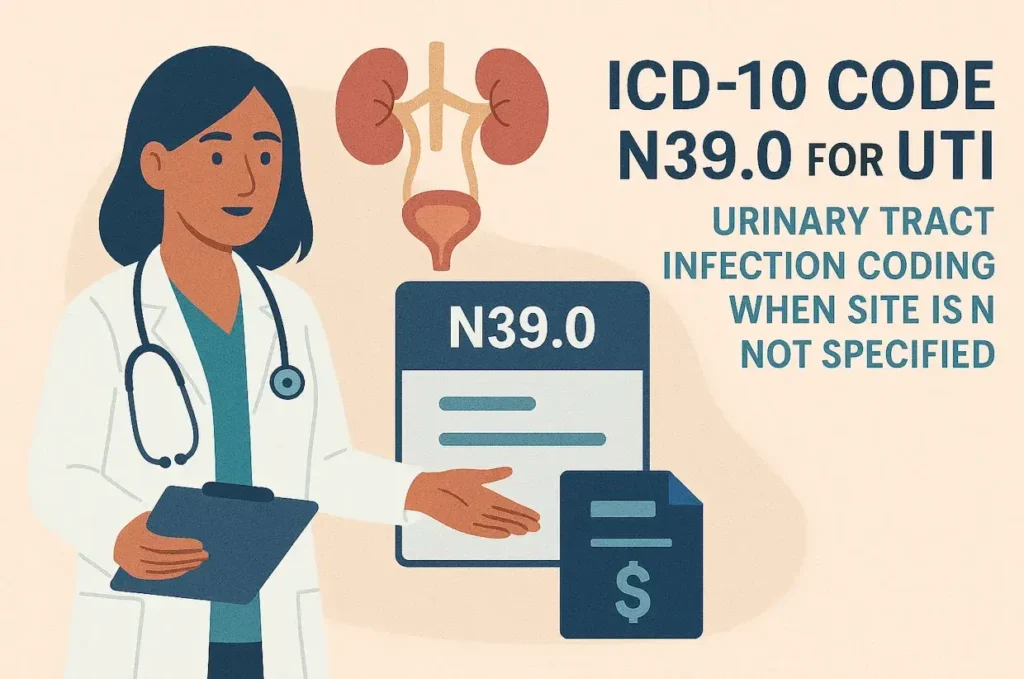Table of Contents
ToggleUnderstanding ICD-10 and the Urinary System in UTI Cases
Urinary tract infections (UTIs) are among the most common bacterial infections affecting the urinary system. These infections primarily impact women and can involve various parts of the tract, including the bladder, urethra, and kidney. In the context of medical billing and coding, selecting the correct ICD-10 code is essential for compliant documentation, accurate reimbursement, and clear clinical communication. This guide explores the appropriate ICD-10-CM diagnosis codes for urinary tract infections, how to specify infection sites, and when to apply an additional code for causative organisms.
ICD-10 Code N39.0 for Urinary Tract Infection: Site Not Specified
When the documentation fails to specify the anatomical site of the infection – whether it is the bladder, kidney, or urethra – the correct diagnosis code to use is:
N39.0 – Urinary tract infection, site not specified
This ICD-10 code is used extensively when a UTI is documented but lacks specificity regarding the infection’s location. It is particularly relevant in cases where lab results or clinical notes don’t define the exact site within the urinary tract. The phrase “site not specified” ensures accuracy without assuming information not provided by the healthcare professional. N39.0 should be used only when no specific site of infection is documented in the medical record. This general code applies across a range of nonspecific urinary infections when a UTI is confirmed.
ICD-10 Codes for UTI: Genitourinary Infections and Site-Based Classification
Common ICD-10-CM Codes for Urinary Tract Infections
-
N39.0 – Urinary tract infection, site not specified. This general diagnosis code is commonly used when the provider does not specify the site of infection within the urinary system.
-
N30.00 – Acute cystitis without hematuria. Apply this when a bladder infection is clearly identified, but there is no blood in the urine.
-
N30.01 – Acute cystitis with hematuria. Use this for UTIs presenting with blood in the urine and affecting the bladder.
-
N30.90 – Cystitis, unspecified. This is relevant when bladder inflammation is documented without details about acute, chronic, or hematuria status.
-
N10 – Acute pyelonephritis. Choose this code when the kidney is affected, often accompanied by flank pain and a burning sensation.
-
N12 – Tubulo-interstitial nephritis, not specified as acute or chronic. Use for kidney inflammation without clear duration or cause.
-
B96.20 / B96.2 – Unspecified Escherichia coli (E. coli) as the causative organism. Add this to highlight E. coli as the pathogen.
-
Z87.440 – Personal history of urinary tract infections. A billable code used for documenting recurrent UTI or past infections involving the ureter or other urinary organs.
Tip: Always include an additional code for the causative organism (such as E. coli, Klebsiella, or Pseudomonas) when lab testing identifies the microbial agent. The appropriate UTI code may vary depending on the precise location and whether chronic infections or pregnancy-related conditions are noted.
When to Specify a More Accurate ICD-10 Code for UTIs
Select a more specific ICD-10-CM code when the affected site is known. The urinary tract has multiple parts, and specificity improves reimbursement and data accuracy.
Site-Based Specific Code Selection for Urinary Tract Infections
-
Bladder infection? Use N30.00 or N30.01.
-
Kidney infection? Use N10.
-
Urethra involvement? Consider urethritis-related codes, particularly for lower urinary tract infections.
Symptom-Driven UTI Code Assignment: Acute, Recurrent, and Abnormalities
-
For acute infections with hematuria, use codes like N30.01.
-
For chronic or recurrent infections, Z87.440 should accompany the primary UTI code.
2025 ICD-10-CM Guidelines for Coding UTIs
Infections During Pregnancy: Coding Guidelines for UTIs
-
Use O23.4 – Infections of the urinary tract in pregnancy.
-
Pair with N39.0 or another site-specific code for complete documentation. Pregnancy-related infections should be sequenced first when applicable.
Recurrent UTIs and Pediatric Coding in the Genitourinary System
-
For children with frequent infections, use N39.0 unless a more specific site is known.
-
Add Z87.440 to represent history of recurrent UTI.
Lower Urinary Tract Infections and Bacterial Agents in ICD-10
Lower urinary tract infections typically involve cystitis, a common diagnosis in ICD-10-CM coding. These infections may be acute, recurrent, or associated with hematuria.
-
Use N30.00 or N30.01 depending on the presence of blood in the urine.
-
The urethra or urethral inflammation may call for codes related to urethritis.
Note: Bacterial agents commonly causing UTIs include E. coli, Klebsiella, Pseudomonas, and Enterococcus. Each should be documented and coded accordingly when identified. Code Z87.440 is especially useful when documenting recurrent UTIs.
N39.0 Coding Tips: Documentation, Billing, and Causative Organism
✅ Do:
-
Use N39.0 when the site is unspecified.
-
Include bacteria-specific codes when lab results confirm an organism.
-
Mention acute symptoms or recurrent history for added detail.
-
Ensure diagnosis codes align with urinalysis or imaging findings.
❌ Don’t:
-
Apply codes for multiple sites without proper documentation.
-
Use unspecified codes when specificity is available.
-
Miss linking symptoms (e.g., hematuria, dysuria) to a proper diagnosis code.
-
Ignore DRG alignment or billing needs when selecting ICD-10 codes.
ICD-10 FAQ: UTIs, Causative Organisms, and Code N39.0
What is the most used ICD-10 code for UTI when the site is unclear?
A: N39.0, which may include infection of the ureter or other nonspecific areas. Use this code when documentation lacks specific information.
Should I always default to ICD-10 Code N39.0 for Urinary Tract Infections?
A: No. Use it only if the site is not specified. Otherwise, apply a more detailed ICD-10 code, especially for cystitis, pyelonephritis, or urethritis.
How to code a UTI caused by a bacterial agent like E. coli?
A: Pair the UTI code (e.g., N39.0) with B96.20 or B96.2 to identify E. coli as the causative agent.
What if hematuria is documented in a urinary tract infection?
A: Use N30.01 for acute cystitis with hematuria.
What about infections without hematuria or with recurrent UTIs?
A: Choose N30.00 or N30.90 depending on available data, and include Z87.440 for recurrent UTI.
Excludes1 and Supplementary Notes for Classified Elsewhere Conditions
When using ICD-10 codes, be mindful of Excludes1 notes- certain conditions cannot be reported together. Also, confirm whether conditions are classified elsewhere before assigning a code. For instance, infections related to procedures or systemic diseases may be found in other sections. Updates to ICD-10-CM codes take effect each year on October 1, so ensure references are current.
Swift Medical Billing: Your Partner in Accurate Coding
At Swift Medical Billing, we help healthcare providers navigate the evolving landscape of ICD-10 coding with precision. Whether you’re coding for a routine UTI diagnosis or addressing chronic infections that affect the bladder and urethra, we ensure accurate coding and timely reimbursements. Our experts stay up to date with October 1 updates and apply the latest 2025 ICD-10-CM coding guidelines. Partner with us to enhance patient care, improve patient outcomes, and stay compliant. Contact us today for a consultation.
Conclusion: Selecting the Right ICD-10 Code for Urinary Tract Infections
Correct ICD-10 coding of urinary tract infections ensures compliant documentation, accurate billing, and proper treatment tracking. Whether the infection affects the bladder, urethra, kidney, or is unspecified, the code selected must reflect the site, symptoms, and microbial agent. This guide helps providers select the most appropriate diagnosis code from the ICD-10-CM list and ensure specificity where possible.
From acute episodes to recurrent cases, UTI documentation should be thorough and compliant with coding guidelines, especially when an additional code is needed to define the organism or infection site. Whether dealing with a recurrent UTI, infections without a clear site, or a case involving pyonephrosis, selecting the proper ICD-10 code for urinary tract infection is essential.
Remember, proper coding benefits patients, providers, and payers alike.




